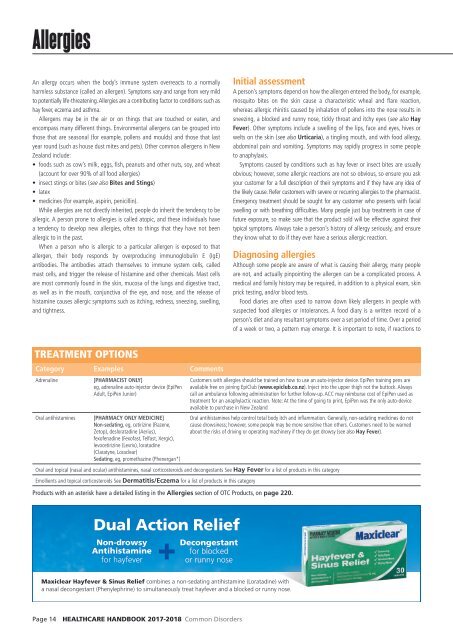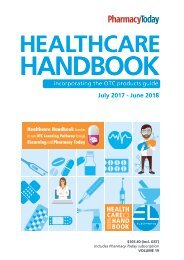2017 HCHB_digital
Create successful ePaper yourself
Turn your PDF publications into a flip-book with our unique Google optimized e-Paper software.
Allergies<br />
An allergy occurs when the body’s immune system overreacts to a normally<br />
harmless substance (called an allergen). Symptoms vary and range from very mild<br />
to potentially life-threatening. Allergies are a contributing factor to conditions such as<br />
hay fever, eczema and asthma.<br />
Allergens may be in the air or on things that are touched or eaten, and<br />
encompass many different things. Environmental allergens can be grouped into<br />
those that are seasonal (for example, pollens and moulds) and those that last<br />
year round (such as house dust mites and pets). Other common allergens in New<br />
Zealand include:<br />
• foods such as cow’s milk, eggs, fish, peanuts and other nuts, soy, and wheat<br />
(account for over 90% of all food allergies)<br />
• insect stings or bites (see also Bites and Stings)<br />
• latex<br />
• medicines (for example, aspirin, penicillin).<br />
While allergies are not directly inherited, people do inherit the tendency to be<br />
allergic. A person prone to allergies is called atopic, and these individuals have<br />
a tendency to develop new allergies, often to things that they have not been<br />
allergic to in the past.<br />
When a person who is allergic to a particular allergen is exposed to that<br />
allergen, their body responds by overproducing immunoglobulin E (IgE)<br />
antibodies. The antibodies attach themselves to immune system cells, called<br />
mast cells, and trigger the release of histamine and other chemicals. Mast cells<br />
are most commonly found in the skin, mucosa of the lungs and digestive tract,<br />
as well as in the mouth, conjunctiva of the eye, and nose, and the release of<br />
histamine causes allergic symptoms such as itching, redness, sneezing, swelling,<br />
and tightness.<br />
Initial assessment<br />
A person’s symptoms depend on how the allergen entered the body, for example,<br />
mosquito bites on the skin cause a characteristic wheal and flare reaction,<br />
whereas allergic rhinitis caused by inhalation of pollens into the nose results in<br />
sneezing, a blocked and runny nose, tickly throat and itchy eyes (see also Hay<br />
Fever). Other symptoms include a swelling of the lips, face and eyes, hives or<br />
welts on the skin (see also Urticaria), a tingling mouth, and with food allergy,<br />
abdominal pain and vomiting. Symptoms may rapidly progress in some people<br />
to anaphylaxis.<br />
Symptoms caused by conditions such as hay fever or insect bites are usually<br />
obvious; however, some allergic reactions are not so obvious, so ensure you ask<br />
your customer for a full description of their symptoms and if they have any idea of<br />
the likely cause. Refer customers with severe or recurring allergies to the pharmacist.<br />
Emergency treatment should be sought for any customer who presents with facial<br />
swelling or with breathing difficulties. Many people just buy treatments in case of<br />
future exposure, so make sure that the product sold will be effective against their<br />
typical symptoms. Always take a person’s history of allergy seriously, and ensure<br />
they know what to do if they ever have a serious allergic reaction.<br />
Diagnosing allergies<br />
Although some people are aware of what is causing their allergy, many people<br />
are not, and actually pinpointing the allergen can be a complicated process. A<br />
medical and family history may be required, in addition to a physical exam, skin<br />
prick testing, and/or blood tests.<br />
Food diaries are often used to narrow down likely allergens in people with<br />
suspected food allergies or intolerances. A food diary is a written record of a<br />
person’s diet and any resultant symptoms over a set period of time. Over a period<br />
of a week or two, a pattern may emerge. It is important to note, if reactions to<br />
TREATMENT OPTIONS<br />
Category Examples Comments<br />
Adrenaline<br />
Oral antihistamines<br />
[PHARMACIST ONLY]<br />
eg, adrenaline auto-injector device (EpiPen<br />
Adult, EpiPen Junior)<br />
[PHARMACY ONLY MEDICINE]<br />
Non-sedating, eg, cetirizine (Razene,<br />
Zetop), desloratadine (Aerius),<br />
fexofenadine (Fexofast, Telfast, Xergic),<br />
levocetirizine (Levrix), loratadine<br />
(Claratyne, Loraclear)<br />
Sedating, eg, promethazine (Phenergan*)<br />
Customers with allergies should be trained on how to use an auto-injector device. EpiPen training pens are<br />
available free on joining EpiClub (www.epiclub.co.nz). Inject into the upper thigh not the buttock. Always<br />
call an ambulance following administration for further follow-up. ACC may reimburse cost of EpiPen used as<br />
treatment for an anaphylactic reaction. Note: At the time of going to print, EpiPen was the only auto-device<br />
available to purchase in New Zealand<br />
Oral antihistamines help control total body itch and inflammation. Generally, non-sedating medicines do not<br />
cause drowsiness; however, some people may be more sensitive than others. Customers need to be warned<br />
about the risks of driving or operating machinery if they do get drowsy (see also Hay Fever).<br />
Oral and topical (nasal and ocular) antihistamines, nasal corticosteroids and decongestants See Hay Fever for a list of products in this category<br />
Emollients and topical corticosteroids See Dermatitis/Eczema for a list of products in this category<br />
Products with an asterisk have a detailed listing in the Allergies section of OTC Products, on page 220.<br />
Dual Action Relief<br />
Non-drowsy<br />
Antihistamine<br />
for hayfever<br />
+<br />
Decongestant<br />
for blocked<br />
or runny nose<br />
Maxiclear Hayfever & Sinus Relief combines a non-sedating antihistamine (Loratadine) with<br />
a nasal decongestant (Phenylephrine) to simultaneously treat hayfever and a blocked or runny nose.<br />
Page 14 HEALTHCARE HANDBOOK <strong>2017</strong>-2018 Common Disorders



